INSTITUT SUPERIEUR D'ANTHROPOLOGIE
INSTITUTE OF ANTHROPOLOGY
ONLINE COURSES / COURS A DISTANCE
SPRING TERM : APRIL 2015
REGISTER NOW
DANEMARK – 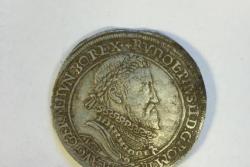 Orenæs- Wielding metal detectors, three amateur archaeologists have unearthed a significant find of 75 large silver coins dating back to the turn of the 17th century, along with fragments of a silver belt, near Orenæs in Falster. Michael Märcher, a museum inspector and coin expert with the National Museum of Denmark, was impressed by the many coins. In total, they weighed two kilos. ”We are talking about silver coins that were the international hard currency of the 1600s,” Märcher told Ekstra Bladet tabloid. ”The coins date from 1593-1650, and about one third of the coins come from the Netherlands.” ”The treasure resembles many of the silver treasures that were hidden away in Jutland and west Funen during the Dano-Swedish Wars of the late 1650s.” It's not the first time that a treasure has been found on the same field in Orenæs. In the 1940s, two silver knife scabbards and two silver belt loops that were worn by well-to-do women of the Renaissance period were also discovered. They are on display at the National Museum of Denmark. The new find will be on display at the Museet Falsters Minder museum in Nykøbing Falster from March 28.
Orenæs- Wielding metal detectors, three amateur archaeologists have unearthed a significant find of 75 large silver coins dating back to the turn of the 17th century, along with fragments of a silver belt, near Orenæs in Falster. Michael Märcher, a museum inspector and coin expert with the National Museum of Denmark, was impressed by the many coins. In total, they weighed two kilos. ”We are talking about silver coins that were the international hard currency of the 1600s,” Märcher told Ekstra Bladet tabloid. ”The coins date from 1593-1650, and about one third of the coins come from the Netherlands.” ”The treasure resembles many of the silver treasures that were hidden away in Jutland and west Funen during the Dano-Swedish Wars of the late 1650s.” It's not the first time that a treasure has been found on the same field in Orenæs. In the 1940s, two silver knife scabbards and two silver belt loops that were worn by well-to-do women of the Renaissance period were also discovered. They are on display at the National Museum of Denmark. The new find will be on display at the Museet Falsters Minder museum in Nykøbing Falster from March 28.
http://cphpost.dk/news/archaeologists-unearth-silver-treasure-in-falster.13045.html?
ROYAUME UNI – 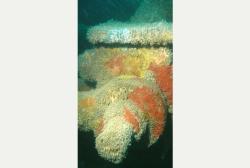 Bristol - For three years, members of a Bristol scuba diving club have meticulously examined the remains of a ship torpedoed by a U-boat in World War One. The Baygitano was travelling from Le Havre in France to Cardiff when it was sunk by U-boat UC-77 in Lyme Bay, off Lyme Regis on March 18, 1918. Both the first mate and fourth engineer were killed in the attack.
Bristol - For three years, members of a Bristol scuba diving club have meticulously examined the remains of a ship torpedoed by a U-boat in World War One. The Baygitano was travelling from Le Havre in France to Cardiff when it was sunk by U-boat UC-77 in Lyme Bay, off Lyme Regis on March 18, 1918. Both the first mate and fourth engineer were killed in the attack.
http://www.bristolpost.co.uk/DIVING-history-TALE-SHiPWRECK/story-26183484-detail/story.html#ixzz3UeebqQmp
ROYAUME UNI – 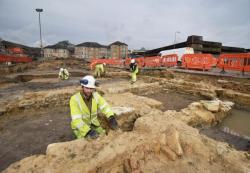 Oxford – The biggest archaeological dig Oxford has ever seen is under way at the site of theWestgate Shopping Centre. More than 60 archaeologists are working there to investigate the remains of 19th century housing and a medieval friary.Oxford Archaeology, the firm carrying out the survey, said many of the remains were hidden underneath the car park that is currently being demolished. The start of the excavations will be focused on old housing at St Ebbes that was built in the 1820s. Much of the area was cleared in the 1960s to make space for the construction of Westgate, but some buildings survived below. The excavations under way – at the former sites of New Street and Friar Street – are thought to be the first in the city to target 19th-century working class housing, the Westgate Oxford Alliance said. And archaeologists believe its findings could add to the national understanding of the effects of industrialism.
Oxford – The biggest archaeological dig Oxford has ever seen is under way at the site of theWestgate Shopping Centre. More than 60 archaeologists are working there to investigate the remains of 19th century housing and a medieval friary.Oxford Archaeology, the firm carrying out the survey, said many of the remains were hidden underneath the car park that is currently being demolished. The start of the excavations will be focused on old housing at St Ebbes that was built in the 1820s. Much of the area was cleared in the 1960s to make space for the construction of Westgate, but some buildings survived below. The excavations under way – at the former sites of New Street and Friar Street – are thought to be the first in the city to target 19th-century working class housing, the Westgate Oxford Alliance said. And archaeologists believe its findings could add to the national understanding of the effects of industrialism.
http://www.oxfordmail.co.uk/news/11859685.History_is_uncovered_as_Westgate_work_continues/
ROYAUME UNI –  Binchester - Durham County Council is leading the dig at the Roman fort in Binchester, County Durham, which is in its final year. The site was one of the biggest finds of its type in recent years and work to excavate the site started in 2009. Beneath layers of Roman rubbish and medieval soil archaeologists uncovered a bath house with 7ft high walls, an inscribed altar dedicated to the Roman Goddess, Fortune the Home-Bringer and a silver ring which is some of the earliest evidence of Christianity in Roman Britain. Dubbed ‘the Pompeii of the North’ the site of Vinovium has been heralded as hugely important to British archaeology.
Binchester - Durham County Council is leading the dig at the Roman fort in Binchester, County Durham, which is in its final year. The site was one of the biggest finds of its type in recent years and work to excavate the site started in 2009. Beneath layers of Roman rubbish and medieval soil archaeologists uncovered a bath house with 7ft high walls, an inscribed altar dedicated to the Roman Goddess, Fortune the Home-Bringer and a silver ring which is some of the earliest evidence of Christianity in Roman Britain. Dubbed ‘the Pompeii of the North’ the site of Vinovium has been heralded as hugely important to British archaeology.
http://www.chroniclelive.co.uk/news/north-east-news/binchester-roman-fort-last-chance-8837341
KOSOVO –  Prizren - Some parts of Prizren Castle, one of the most important historical sites in the Balkans, have collapsed despite the recent donation of funds to restore the structure. A 10-meter part of the façade of the castle, which was used by the Ottomans during their reign in the Balkans for 500 years, recently collapsed. he history of the castle, located in the southern city of Prizren, which has a high Turkish population, dates back to the Roman era. The historical castle was extended during the Ottoman era and served the empire for 500 years. Overlooking Prizren, the castle includes many inns, bathes and mosques.
Prizren - Some parts of Prizren Castle, one of the most important historical sites in the Balkans, have collapsed despite the recent donation of funds to restore the structure. A 10-meter part of the façade of the castle, which was used by the Ottomans during their reign in the Balkans for 500 years, recently collapsed. he history of the castle, located in the southern city of Prizren, which has a high Turkish population, dates back to the Roman era. The historical castle was extended during the Ottoman era and served the empire for 500 years. Overlooking Prizren, the castle includes many inns, bathes and mosques.
http://www.hurriyetdailynews.com/ottoman-castle-in-kosovo-collapses.aspx?pageID=238&nID=79638&NewsCatID=375
ESPAGNE – 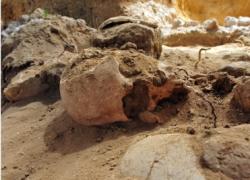 Madrid - Des archéologues ont retrouvé les restes de Miguel de Cervantès, l’auteur de « Don Quichotte », dans l’église des Mères Trinitaires, dans le centre historique de Madrid. Si l’annonce a été faite ce mardi 17 mars, les fouilles elles ont commencé il y a plus d’un an. Francisco Etxeberria, l’anthropologue directeur de l’équipe scientifique chargée des recherches, se félicite : « Après analyse de toute information, il est possible de considérer que parmi les fragments de la réduction découverte dans le sol de la crypte de l’actuelle église des Trinitaires se trouvent certains appartenant à Miguel de Cervantès ». C’est désormais officiel : le cercueil frappé des initiales « M.C », découvert dans la crypte invisible de l’église des Mères Trinitaires sont bien ceux de l’auteur de Don Quichotte. Un travail méticuleux et de longue haleine qui n’a en rien découragé les archéologues. Ils disposaient de nombreux indices pour identifier « le Grand Homme du Siècle d’or ». « Nous recherchions un squelette d’homme, environ 1m70, qui avait six dents, ou moins, portant des [traces de] lésions à l’intérieur du bras et à la main gauche, ne relevant pas de l’amputation, mais interdisant l’usage normal du bras ». Une particularité qui a fait la différence. Miguel de Cervantès a été blessé à la bataille navale de Lépante, de deux coups d'arquebuse qui lui ont paralysé de la main gauche. L’auteur avait été enterré dans ce quartier de Madrid en avril 1616, mais on ignorait le lieu exact de sa sépulture, perdue au fil de l’histoire et des travaux d’agrandissement de l’église. Pour autant, si le conditionnel n'est plus d'usage, « il n'y a [toujours] pas d'identification confirmée par la voie génétique ».
Madrid - Des archéologues ont retrouvé les restes de Miguel de Cervantès, l’auteur de « Don Quichotte », dans l’église des Mères Trinitaires, dans le centre historique de Madrid. Si l’annonce a été faite ce mardi 17 mars, les fouilles elles ont commencé il y a plus d’un an. Francisco Etxeberria, l’anthropologue directeur de l’équipe scientifique chargée des recherches, se félicite : « Après analyse de toute information, il est possible de considérer que parmi les fragments de la réduction découverte dans le sol de la crypte de l’actuelle église des Trinitaires se trouvent certains appartenant à Miguel de Cervantès ». C’est désormais officiel : le cercueil frappé des initiales « M.C », découvert dans la crypte invisible de l’église des Mères Trinitaires sont bien ceux de l’auteur de Don Quichotte. Un travail méticuleux et de longue haleine qui n’a en rien découragé les archéologues. Ils disposaient de nombreux indices pour identifier « le Grand Homme du Siècle d’or ». « Nous recherchions un squelette d’homme, environ 1m70, qui avait six dents, ou moins, portant des [traces de] lésions à l’intérieur du bras et à la main gauche, ne relevant pas de l’amputation, mais interdisant l’usage normal du bras ». Une particularité qui a fait la différence. Miguel de Cervantès a été blessé à la bataille navale de Lépante, de deux coups d'arquebuse qui lui ont paralysé de la main gauche. L’auteur avait été enterré dans ce quartier de Madrid en avril 1616, mais on ignorait le lieu exact de sa sépulture, perdue au fil de l’histoire et des travaux d’agrandissement de l’église. Pour autant, si le conditionnel n'est plus d'usage, « il n'y a [toujours] pas d'identification confirmée par la voie génétique ».
http://www.reponseatout.com/insolite/drole/cervantes-les-ossements-enfin-identifies-a1014500
CHINE – Xiangcheng - Les archéologues chinois ont découvert une série de tombeaux, dont certains sont remplis de trésors anciens, sur un chantier à Zhoukou, dans la province centrale du Henan. Ce site archéologique, situé à Xiangcheng, une ville de niveau de district, comporte 21 tombeaux datant de milliers d'années et couvrant la période des Royaumes combattants (475-221 av.J-C) et la dynastie des Han orientaux (25-220), a indiqué Han Yanzhen, expert à l'Institut du patrimoine culturel de Zhoukou. Parmi ces tombeaux, dix-neuf sont des fosses en terre et deux autres sont des tombes en briques. Selon les archéologues, seulement cinq tombeaux ont échappé au pillage. De nombreux objets funéraires tels que de la poterie, des articles en bronze et des bijoux ont été découverts dans les tombeaux. Une épée en bronze bien préservée fait partie des découvertes les plus rares, a indiqué M. Han. Les archéologues ont indiqué que les trésors dans les tombeaux permettraient aux chercheurs de mieux étudier la forme et la structure des tombeaux, la culture et les coutumes entre la période des Royaumes combattants et celle de la dynastie des Han orientaux.
Xiangcheng - Les archéologues chinois ont découvert une série de tombeaux, dont certains sont remplis de trésors anciens, sur un chantier à Zhoukou, dans la province centrale du Henan. Ce site archéologique, situé à Xiangcheng, une ville de niveau de district, comporte 21 tombeaux datant de milliers d'années et couvrant la période des Royaumes combattants (475-221 av.J-C) et la dynastie des Han orientaux (25-220), a indiqué Han Yanzhen, expert à l'Institut du patrimoine culturel de Zhoukou. Parmi ces tombeaux, dix-neuf sont des fosses en terre et deux autres sont des tombes en briques. Selon les archéologues, seulement cinq tombeaux ont échappé au pillage. De nombreux objets funéraires tels que de la poterie, des articles en bronze et des bijoux ont été découverts dans les tombeaux. Une épée en bronze bien préservée fait partie des découvertes les plus rares, a indiqué M. Han. Les archéologues ont indiqué que les trésors dans les tombeaux permettraient aux chercheurs de mieux étudier la forme et la structure des tombeaux, la culture et les coutumes entre la période des Royaumes combattants et celle de la dynastie des Han orientaux.
http://french.peopledaily.com.cn/Culture/n/2015/0316/c31358-8863606.html
PEROU – 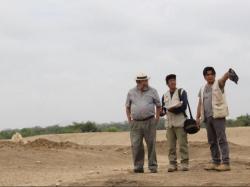 Lambayeque - The Northern region of Peru, Lambayeque, will be investigated for Mochica burial remains in three sites starting next month. Archaeologist Walter Alva with the Royal Tombs of Sipan Museum research team will be researching the Mat Indio, El Triunfo, and La Inmaculada Mochica settlements of Lambayeque for possible funerary information according to Andina news agency. Researcher Alva announced the plans after the technical team of the Executive Unit 005 Naylamp-Lambayeque with his direction, identified the perimeters of the three sites. With a geo-referencing system, the team has begun to specify excavation units and coordinates of the unique archaeological sites. The investigative team hopes to fine-tune these spatial similarities so that more definitive lines can be drawn between Mata Indio, El Triunfo, and La Inmaculada. These three sites were clearly at some point occupied by Mochica populations in the Pre-Colombian era and therefore share these common qualities. However, the research teams are looking to define the relations between Sipan and Pampa Grande. The Mochica culture (stemming from Moche civilization), are also known as Early Chimu, Pre-Chimu, or Proto-Chimu, and reigned over much of Northern Peruvian coastline from 100 AD to 800 AD. Pampa Grande is located between the Chancay River and the mountains in that region. Therefore the Mochica in the Pampa Grande region developed a unique Mochica culture, specific to that environment. Researchers want to understand how and when these differences developed.
Lambayeque - The Northern region of Peru, Lambayeque, will be investigated for Mochica burial remains in three sites starting next month. Archaeologist Walter Alva with the Royal Tombs of Sipan Museum research team will be researching the Mat Indio, El Triunfo, and La Inmaculada Mochica settlements of Lambayeque for possible funerary information according to Andina news agency. Researcher Alva announced the plans after the technical team of the Executive Unit 005 Naylamp-Lambayeque with his direction, identified the perimeters of the three sites. With a geo-referencing system, the team has begun to specify excavation units and coordinates of the unique archaeological sites. The investigative team hopes to fine-tune these spatial similarities so that more definitive lines can be drawn between Mata Indio, El Triunfo, and La Inmaculada. These three sites were clearly at some point occupied by Mochica populations in the Pre-Colombian era and therefore share these common qualities. However, the research teams are looking to define the relations between Sipan and Pampa Grande. The Mochica culture (stemming from Moche civilization), are also known as Early Chimu, Pre-Chimu, or Proto-Chimu, and reigned over much of Northern Peruvian coastline from 100 AD to 800 AD. Pampa Grande is located between the Chancay River and the mountains in that region. Therefore the Mochica in the Pampa Grande region developed a unique Mochica culture, specific to that environment. Researchers want to understand how and when these differences developed.
http://www.peruthisweek.com/news-archaeologists-investigate-three-mochica-sites-105562